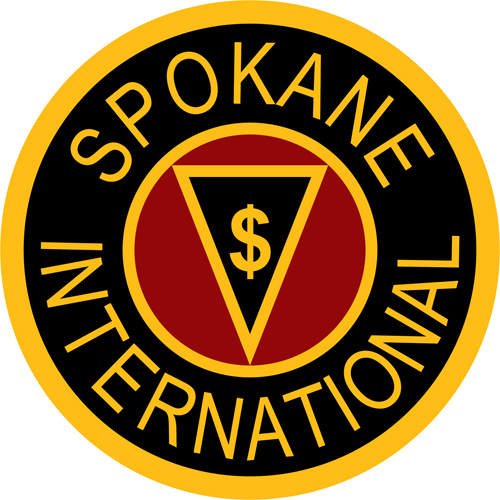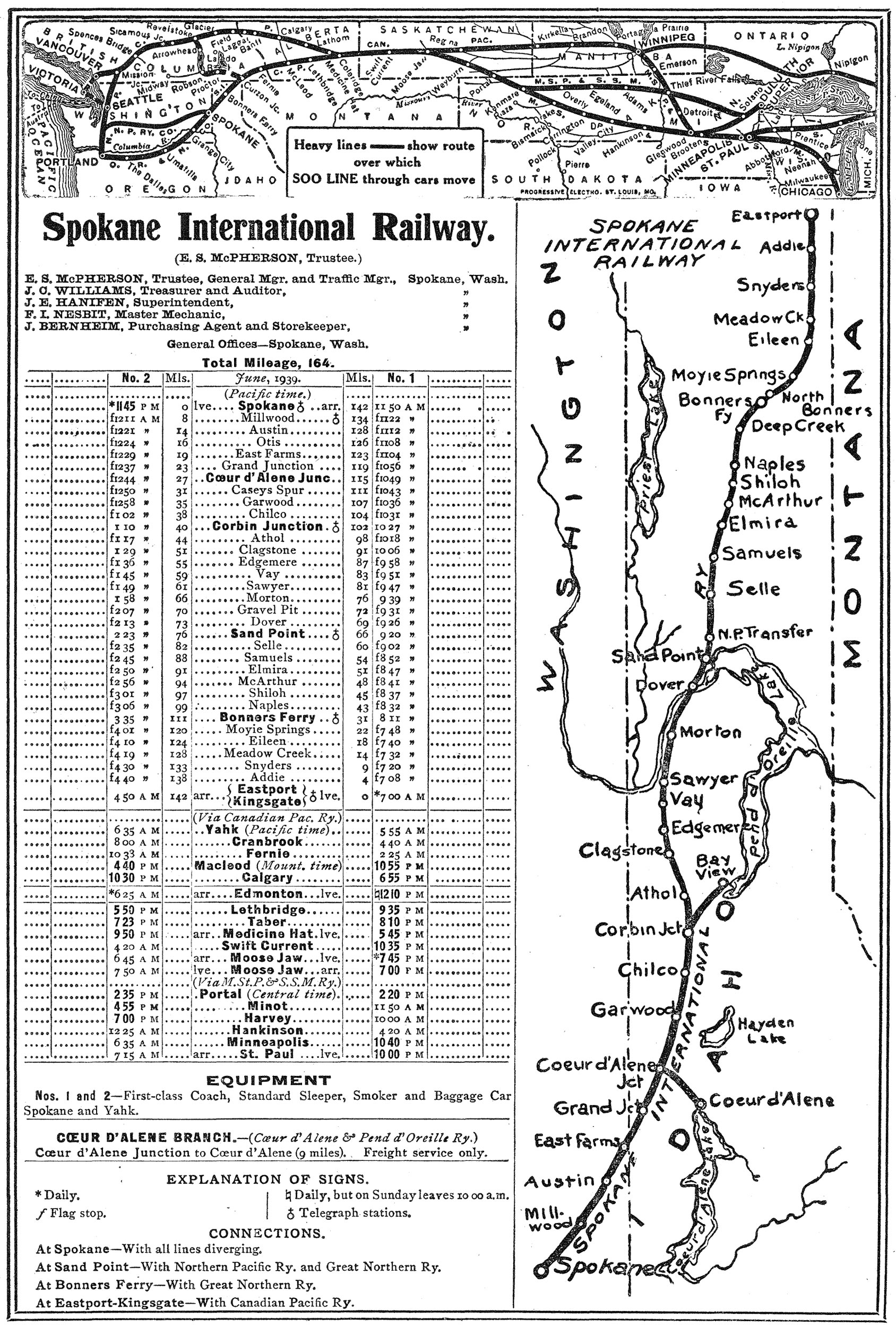Spokane International Railroad
Last revised: August 23, 2024
By: Adam Burns
The Spokane International Railroad was a small, Class I, system that
served its namesake town as well as most of Idaho's northern panhandle
before terminating in extreme southern British Columbia along a route
that was roughly 150 miles in length.
Due to its remote nature in the upper Pacific Northwest it is often forgotten among the ranks of the classic fallen flag systems.
The SI was funded and built (although not owned) thanks to the Canadian Pacific, which had an interest in the route itself as a means of tapping into the growing Puget Sound traffic base, then controlled by the Northern Pacific and soon after, Great Northern.
Eventually, the system was wrestled away from CP by Union Pacific in the late 1950s. Officially, the SI remained on paper for roughly another 30 years before being dissolved. Today, the entire SI main line remains in use by UP as a strategic connection with CP.
Photos
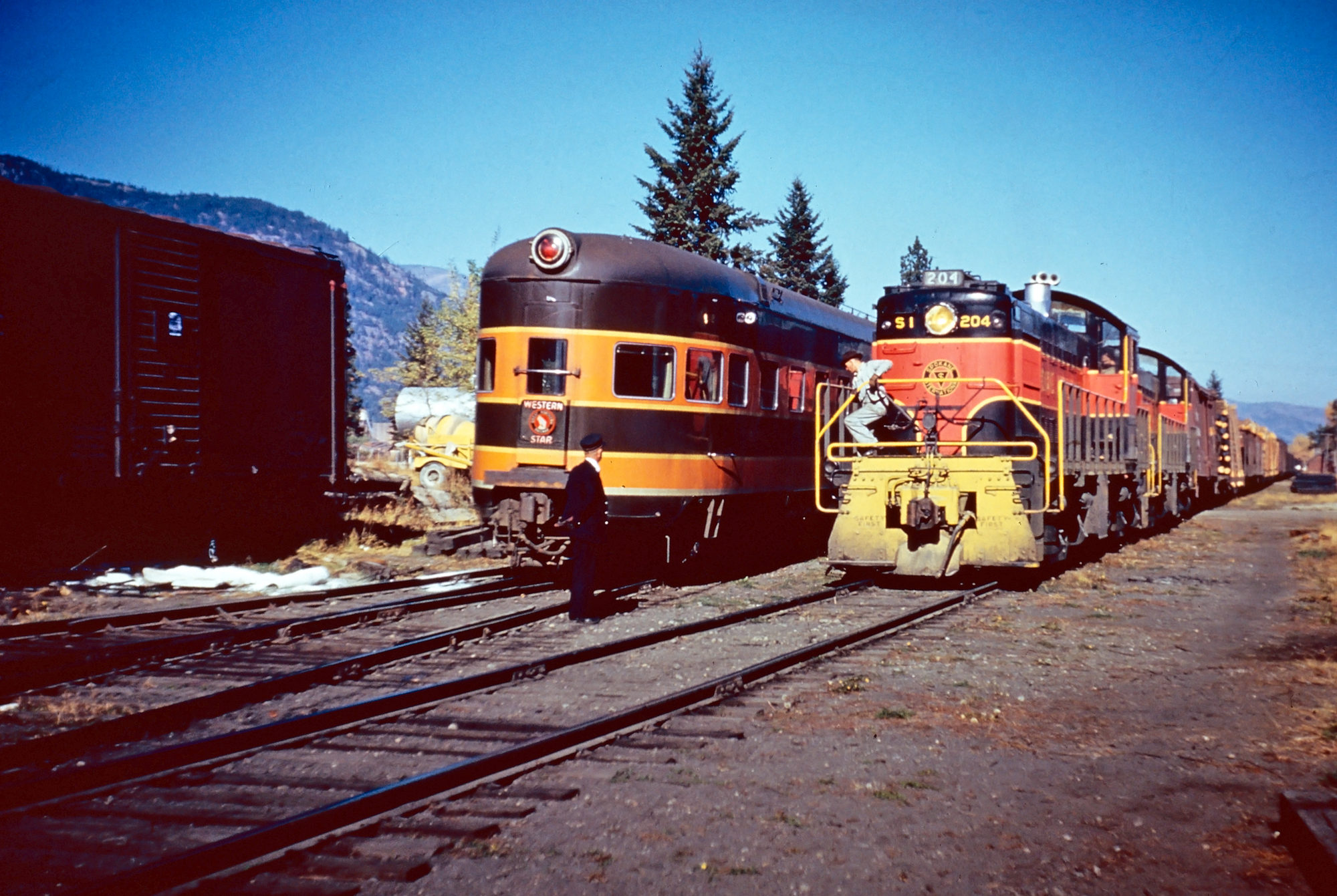 A pair of Spokane International RS1s, led by #204, are seen here at work in Sandpoint, Idaho while Great Northern's "Western Star" can be seen on the adjacent track on October 30, 1954. Photographer unknown. American-Rails.com collection.
A pair of Spokane International RS1s, led by #204, are seen here at work in Sandpoint, Idaho while Great Northern's "Western Star" can be seen on the adjacent track on October 30, 1954. Photographer unknown. American-Rails.com collection.History
The Spokane International Railroad (SI) was the idea of Daniel Chase (DC) Corbin in the late 1880s with financial assistance from Canadian Pacific. The CP was already established across most of Canada from Ontario to British Columbia.
Additionally, it had recently taken control of the Minneapolis, St. Paul & Sault Ste. Marie Railway (the Soo Line) to access the Midwest. Since 1883 the Northern Pacific had been operating from Portland, Oregon to the Twin Cities of Minnesota and with the prospect of two more lines building transcontinental extensions to the Puget Sound (Great Northern, which was already under construction, and the Chicago, Milwaukee & St. Paul) CP wanted in on the traffic potential the region offered.
In sort of a roundabout fashion, it planned to use its Soo subsidiary to funnel traffic from Chicago and onto its main line at Manitoba and then transfer freight onto the SI.
At A Glance
Spokane, Washington - Sandpoint, Idaho - Eastport, Idaho Coeur d'Alene Junction - Coeur d'Alene Corbin Junction, Idaho - Bayview, Idaho | |
From this point it could interchange traffic with what would turn out to be four different major Class Is at five different locations; Spokane (Milwaukee Road after 1909, Great Northern, Northern Pacific, and Union Pacific), Sand Point (CMStP&P and NP), Bonners Ferry (GN), and Coeur D'Alene (CMStP&P/GN).
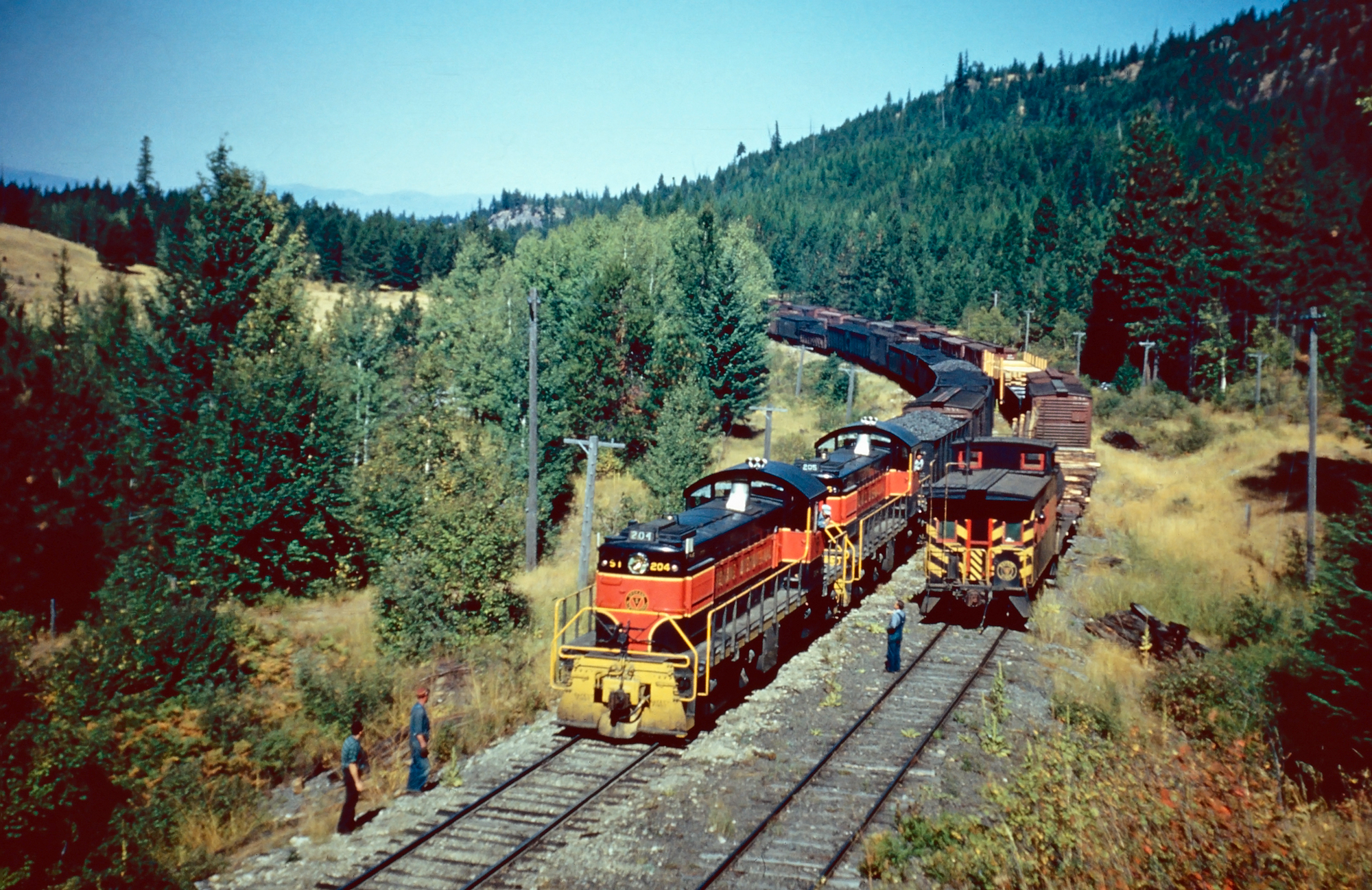 Spokane International RS1s, #204 and #205, have a coal train at Shiloh, Idaho as another freight waits in the siding on July 12, 1953. Photographer unknown. American-Rails.com collection.
Spokane International RS1s, #204 and #205, have a coal train at Shiloh, Idaho as another freight waits in the siding on July 12, 1953. Photographer unknown. American-Rails.com collection.Construction
The Spokane International Railway was chartered as early as 1887. However, actual construction did not begin until a few years later.
Officially, the SI was opened on November 1, 1906 connecting with the CP at the international border of Eastport, Idaho/Kingsgate, British Columbia with Spokane, Washington to the south, a distance of 140.8 miles according to the railroad's timetable (it later used CP trackage rights to reach Yahk, B.C. just north of the border).
With its own U.S.-transcontinental route now opened CP not only moved to derive the freight benefits but also the passenger potential as well.
Even subsidiary Soo Line was anticipating this potential decrying the SI as "The New Scenic Short Line" by the summer of 1907.
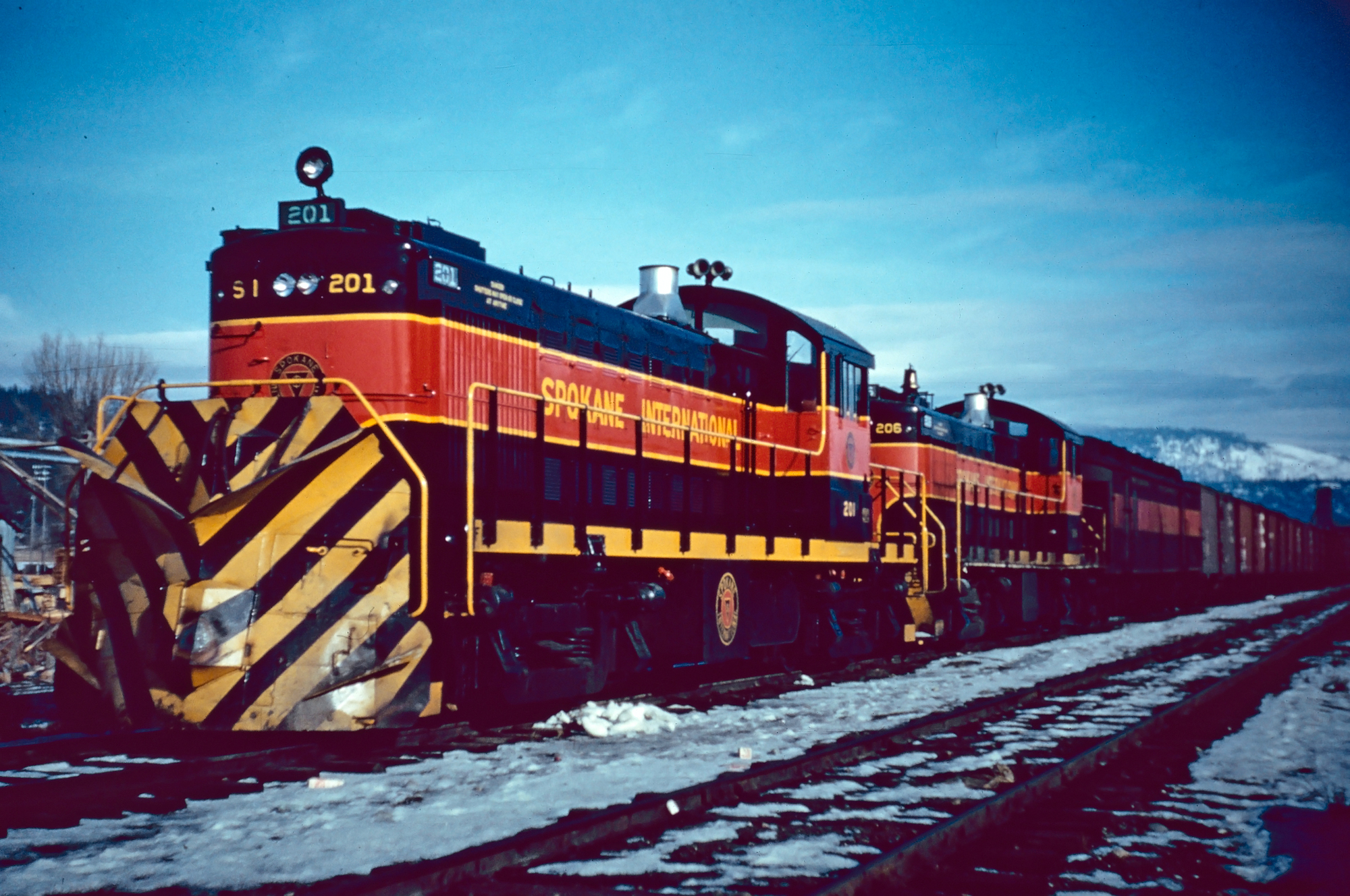 A pair of sharp Spokane International RS1s, #201 and #206, appear to be tied down in Bonners Ferry, Idaho on December 15, 1954. Photographer unknown. American-Rails.com collection.
A pair of sharp Spokane International RS1s, #201 and #206, appear to be tied down in Bonners Ferry, Idaho on December 15, 1954. Photographer unknown. American-Rails.com collection.Operation
That same year the SI, Soo, and CP launched the Soo-Spokane Train DeLuxe which offered passengers first-class accommodations including day coaches, tourist sleeping cars, diners, Pullman sleepers, compartment cars, and buffet-library observations.
While the train ran a longer schedule and only connected the Twin Cities to Spokane its level of comfort and luxuriousness was nearly unmatched (for the early 1900s it even boasted full electric lighting and all-vestibuled cars).
Traffic on the SI continued to grow through the first two decades of the 20th century and by 1918 it had gained Class I status by earning more than $1 million annually. A year earlier the CP exercised its option to purchase 50% controlling interest in the line.
Logo
It likely would have acquired more of the SI if it was not for Union Pacific's move to acquire the other half at the same time, which it would never relinquish. The railroad continued to hum along through the World War I conflict and the "Roarin' 20s."
However, it was hit hard by the Great Depression of 1929 and its lingering effects on the U.S. economy. By 1933 things were looking dire and that year the SI filed for bankruptcy. In 1941 the company was finally able to exit receivership as the Spokane International Railroad, which eliminated the CP's ownership and resulted in the line being a wholly-U.S. route only.
Traffic for the railroad continued to grow through the 1940s, particularly during the second World War, so much so that by late that decade its 2-8-0 Consolidations and 4-6-0 Ten Wheelers could no longer keep up with demand.
System Map and Timetable (1940)
While the WWII traffic boom allowed the SI to regain Class I status it was still not being operated efficiently. In 1949 this changed under new leadership by Fred Rummel, as the SI purchased 12 new American Locomotive Company (Alco) RS1 road-switchers, sticking with the same company which had built its steam locomotives.
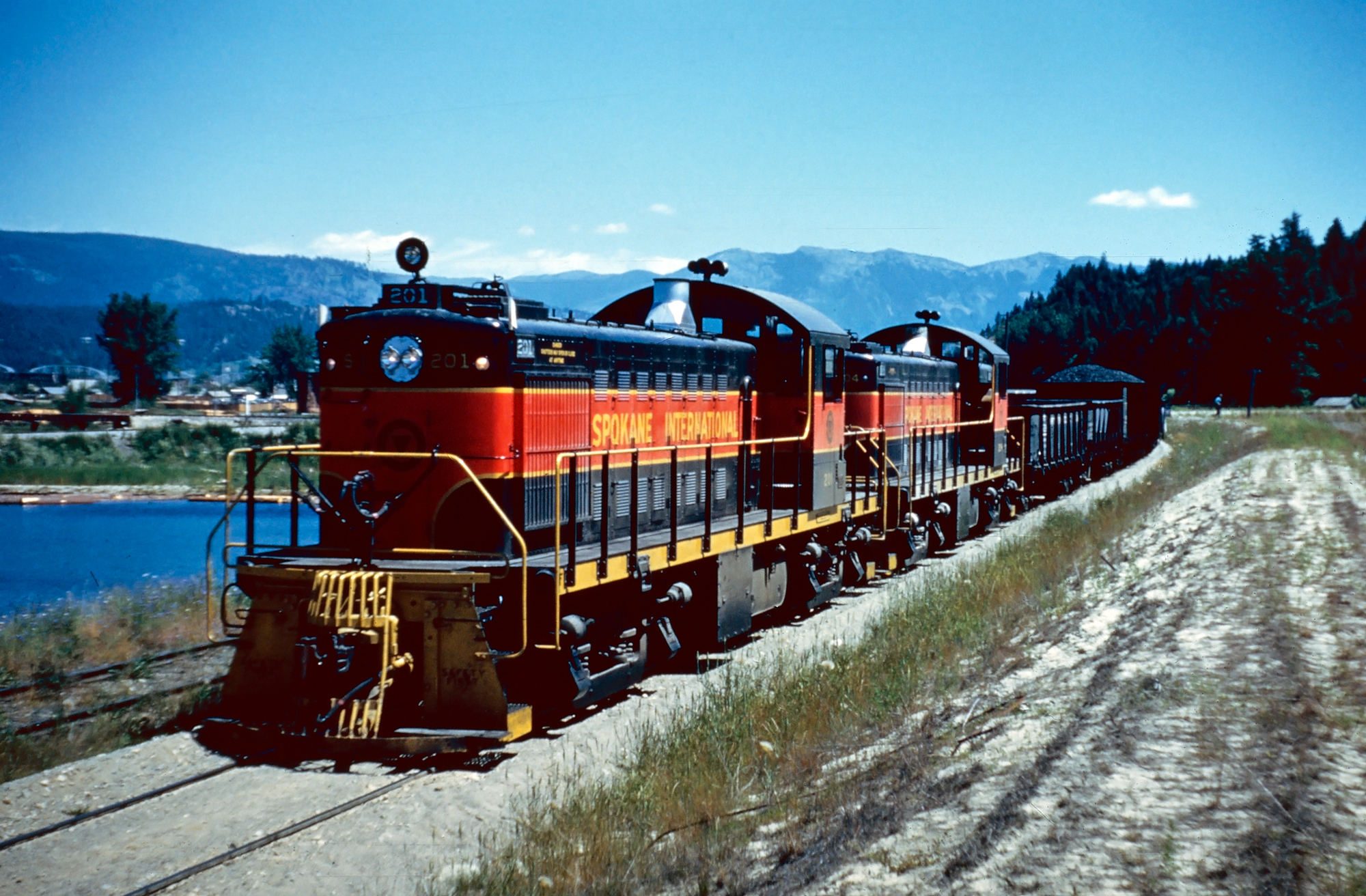 Spokane International RS1s #201 and #204 are seen here in freight service at Bonners Ferry, Idaho on May 1, 1954. Photographer unknown. American-Rails.com collection.
Spokane International RS1s #201 and #204 are seen here in freight service at Bonners Ferry, Idaho on May 1, 1954. Photographer unknown. American-Rails.com collection.Rummel was able to accomplish several other tasks at the helm, which turned the railroad into an incredibly well-run operation that lured Union Pacific into purchasing full ownership of the line.
Starting at the same time he purchased the new Alcos, the railroad was upgraded with new creosote ties (before this it was still using untreated ties that dated to the route's construction) and 90-pound rail (up from 72-pound).
Diesel Locomotive Roster
| Builder | Model Type | Road Number | Notes | Quantity |
|---|---|---|---|---|
| Alco | RS1 | 200-211 | Acquired new: 1949-1951 | 12 |
(Thanks to Trains Magazine's "Union Pacific To Canada?" from the June, 1956 issue as a primary reference for this article.)
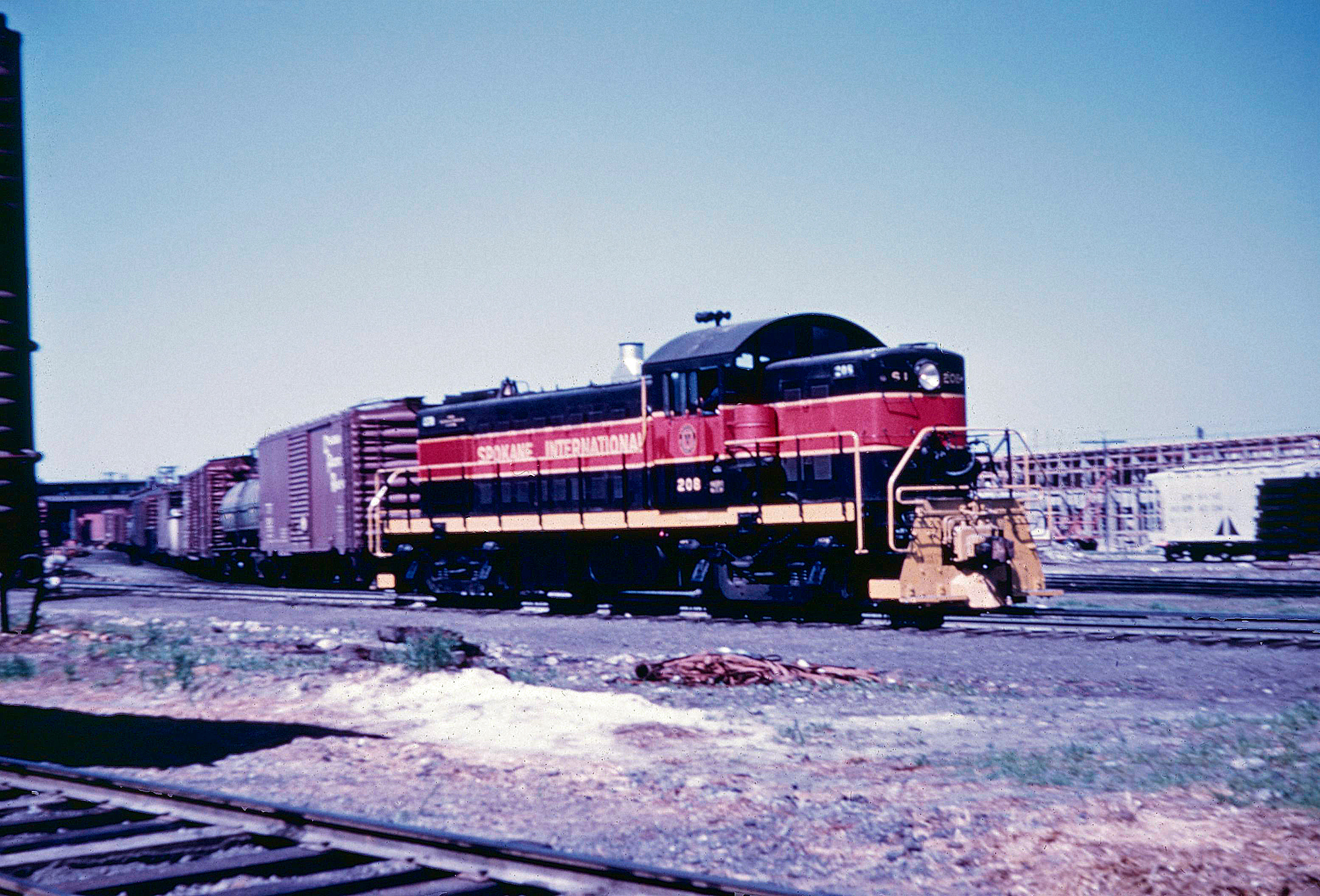 Spokane International RS1 #208 carries out switching chores in Spokane, Washington in 1958. American-Rails.com collection.
Spokane International RS1 #208 carries out switching chores in Spokane, Washington in 1958. American-Rails.com collection.Union Pacific
Additionally, a new bridge was constructed over the Pend Oreille River near Sandpoint and the railroad dropped all passenger services after 1954.
As a result of these efforts the company's operating ratio dropped from 87.25% in 1949 to a staggering 52.55% by 1955! In 1958 Union Pacific purchased the rest of the SI ending the 82-year history of the company.
By the early 1960s its classic red and gold RS1s were repainted into UP Armour yellow, although sub-lettered for the SI.
Officially the company ceased to exist on December 31, 1987 when UP formally dissolved the SI. Today, its route remains an important part of the Union Pacific system that still connects with the Canadian Pacific at Sand Point/Kingsgate.
Contents
Recent Articles
-
North Dakota Rails: Riding Through Scenic Wonders
Feb 25, 25 11:51 AM
Unfortunately, North Dakota train rides are few. Only the Fort Lincoln Trolley offers such trips. The state is also home to handful of museums, the most notable of which is the North Dakota State Rail… -
Scenic Adventures In North Carolina By Train
Feb 25, 25 06:59 AM
North Carolina train rides offer many restored steam locomotives to see in action and plenty of scenery. The information here provides complete coverage of train rides in NC, from the Tweetsie Railroa… -
Enchanting Rails: New Mexico's Scenic Trains
Feb 24, 25 11:21 PM
Only two New Mexico train rides are open to the public although one is the incredibly successful and picturesque Cumbres and Toltec Scenic Railroad.
